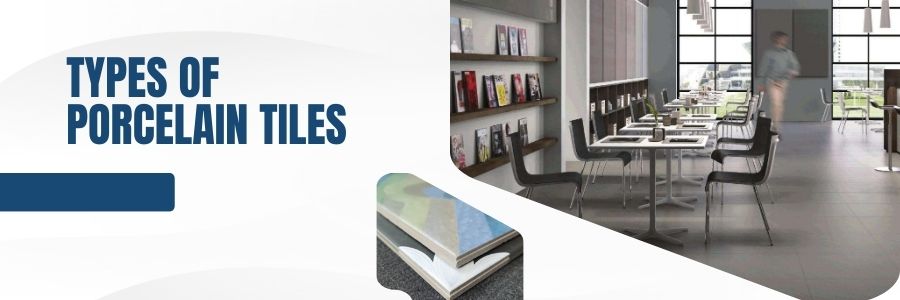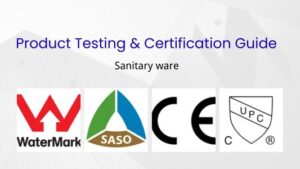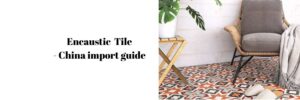Porcelain tiles have become increasingly popular in global markets due to their incredible versatility and durability. If you’re an importer, understanding the different types of porcelain tiles is crucial for making informed purchasing decisions.
In this comprehensive guide, we will explore various types of porcelain tile, including finishes, looks, and bodies, providing you with the essential knowledge needed to select the best options for your projects. Now let’s start!
Classification by Porcelain Tile Surface / Finish
When it comes to porcelain tiles, the finish really matters. It affects not just how the tiles look, but also how they perform. The tile finish determines things like texture, shine, and even how slip-resistant they are. So it’s important to choose the right one for your needs.
Typically, we categorize tiles into the following types based on their surfaces: glazed porcelain tile, unglazed full-body porcelain tile, and polished porcelain tile.
Glazed Porcelain Tile


Glazed porcelain tiles are among the most popular choices for both residential and commercial spaces. These tiles feature a layer of liquid glass on their surface, which is fused to the body of the tile during firing. This layer not only enhances the tile’s aesthetic appeal, providing a glossy or matte finish, but also gives them extra protection against stains and scratches, making them both beautiful and durable.
Glazed porcelain tiles come in various styles, colors, and patterns, making them extremely versatile for any design project.
Advantages:
Wide range of design options: The glaze surface offers a variety of design options, from vibrant colors to intricate patterns, enabling aesthetic flexibility, and you can customize the color and patterns as you want.
Easy to clean and minimal maintenance.
Common Uses:
Residential flooring, bathrooms, and decorative wall tiles.
Unglazed Porcelain Tile – Homogeneous Tile
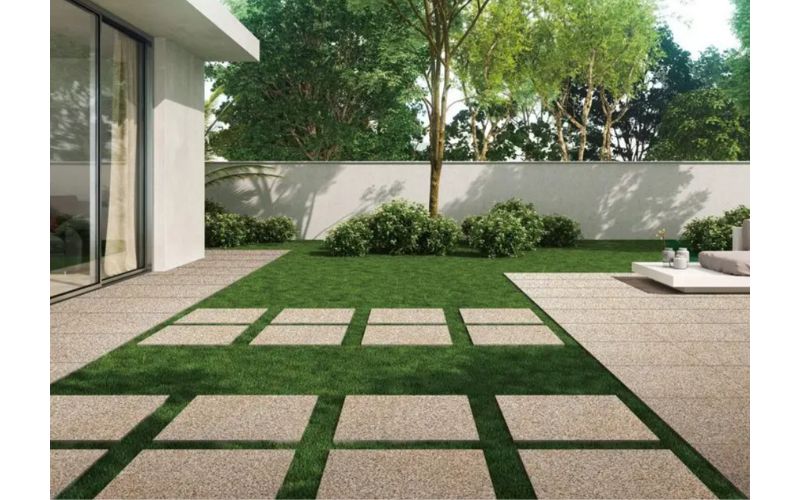

Unglazed porcelain tile is also called homogeneous tile or full-body tile, its surface is without glaze. These tiles are generally more durable and have a consistent color throughout, which is perfect for high-traffic and slip-resistant areas.
Advantages:
Highly durable, and slip-resistant.
Common Uses:
Commercial spaces, outdoor areas, and high-traffic environments.
Polished Porcelain Tile
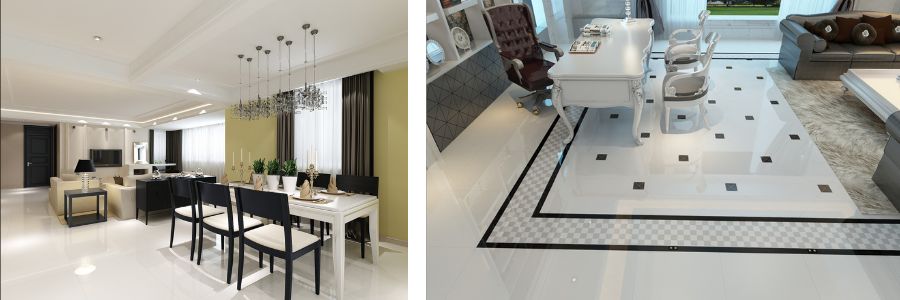

Polished porcelain tiles are famous for their smooth, shiny, mirror-like finish. This kind of polished finish is achieved through a fine polishing process rather than glazing, it combines the tile’s natural beauty and is still as durable and strong as you’d expect from porcelain.
Soluble salt, and double loading tile are also polished porcelain tile.
Advantages:
Elegant appearances and reflective surfaces can make your rooms look spacious.
Common Uses:
Upscale residential spaces, such as living rooms and commercial interiors.
Below are some of the finishes you may usually hear: full polished, semi-polished, matte, and grip finished.
Full Polished Finish


Full polished porcelain tiles are a type of glazed porcelain tile that undergoes an extensive polishing process on the glazing of the tile to achieve an ultra-glossy, reflective surface.
Different from the normal polished porcelain tile, full-polished tile has more designs and patterns, as it can mimic natural stone, like marble, terrazzo, or granite.
Advantages:
Their high-end aesthetic and reflective properties can enhance light in any room. And provide you with a luxury look like marble.
Common Uses:
High-end residential projects, commercial lobbies, and showrooms.
Semi-Polished Finish
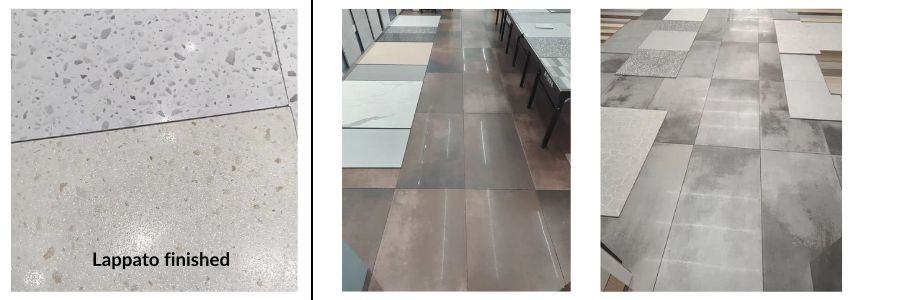

The semi-polished finish is also known as lappato.
The term “Lappato” actually comes from the Italian word for “semi-polished”. The semi-polished tiles are the sweet spot between the shiny finish of fully polished tiles and the subtle look of matte tiles.
During manufacturing, the surface is partially polished to create a subtle sheen that enhances the tile’s natural beauty without the full mirror-like effect of a completely polished tile. This partial polishing technique results in a surface that balances both shine and texture, providing an elegant yet practical option for various interior settings.
Advantages:
Offer a sophisticated look that reflects light beautifully, adding depth and dimension to any room. At the same time, their slight texture provides better slip resistance compared to fully polished tiles, making them safer for areas like bathrooms and kitchens.
Ease of maintenance is another significant benefit;
Common Uses:
Living rooms, hallways, and commercial spaces seek a refined yet functional flooring solution.
Matt Finish
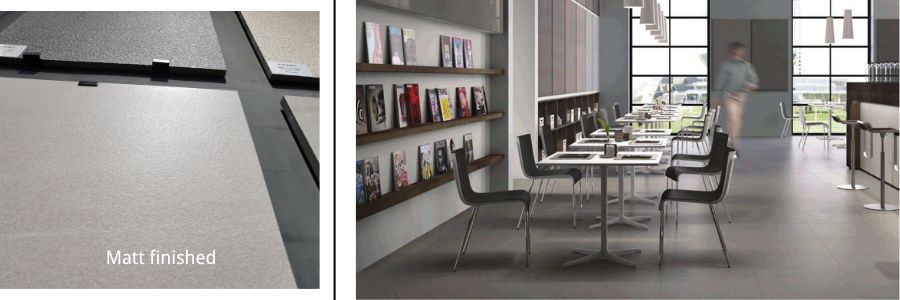

A matt finish porcelain tile is defined by its smooth, non-reflective surface that offers a sleek and understated elegance. Unlike glossy or polished finishes, matt surfaces have a flat appearance that doesn’t reflect light, lending them a contemporary and minimalist aesthetic.
Advantages:
They offer a modern look, suitable for minimalist designs.
Slip-resistance, and are incredibly easy to maintain.
Looks comfortable.
Common Uses:
Residential or commercial areas, and also an excellent choice for areas prone to moisture, such as bathrooms, kitchens, and outdoor patios.
Grip Finish
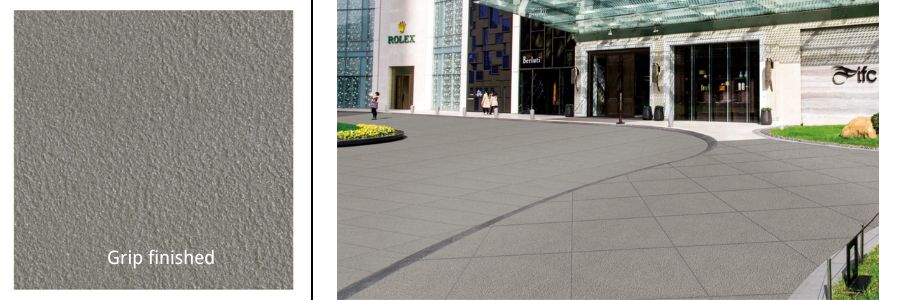

The grip finish on porcelain tiles has a textured surface designed to enhance safety. Unlike smooth finishes, the grip finish incorporates a slightly rough texture that provides additional traction underfoot, significantly reducing the risk of slips and falls. This makes it especially suitable for use in wet areas such as bathrooms, kitchens, poolsides, and outdoor patios, as well as commercial spaces with high foot traffic.
Advantages:
These tiles are slip-resistant, and highly resistant to moisture and stonas, making them ideal for wet, high-traffic areas, and ease of care.
Common Uses:
Best for outdoor patios, pool surrounds, commercial kitchens, public spaces like spas, and hotels.
Next, we’ll look at some of the looks and bodies of porcelain tiles to have a complete understanding of this versatile material.
Classification by Porcelain Tile Looks
With the advancements in manufacturing technologies, porcelain tiles types come in various styles that mimic other materials, offering endless design possibilities:
Wood-Look Porcelain Tiles


Wood-look porcelain tile uses high-definition ink jet printing technology to replicate the grain, color variations, and texture of real wood planks, ranging from classic oak to exotic teak. It provides a practical solution for achieving a timeless and elegant look, offering the beauty of wood floors without the upkeep, and without the susceptibility to water damage, scratches, or wear that comes with natural wood.
They are perfect for spaces like bedrooms, kitchens, balconies, and living rooms where you want the charm of wood but need the durability of porcelain. Their resistance to moisture and stains also makes them suitable for outdoor spaces.
Marble-Look Porcelain Tiles
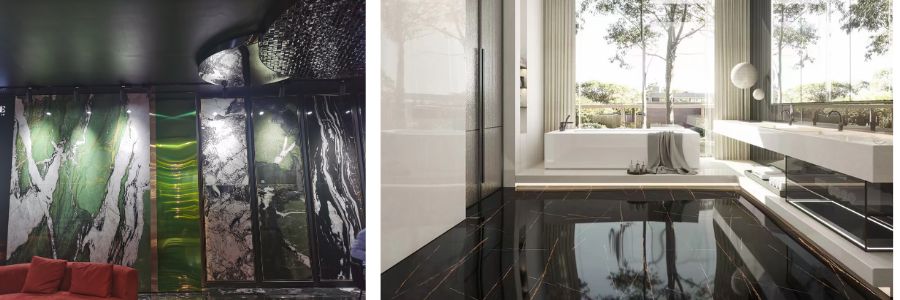

Marble-look porcelain tiles offer the exquisite beauty and veining of natural marble combined with the durability and ease of maintenance that come with porcelain.
Through advanced inkjet printing technology, these tiles capture the intricate patterns and rich color variations of marble, from the delicate whites and greys of Carrara to the deep blacks of Marquina, they create an elegant and sophisticated feeling for any space, whether in bathrooms or commercial lobbies and hallways, at a fraction of the cost and without the upkeep associated with real marble.
Concrete-Look Porcelain Tiles
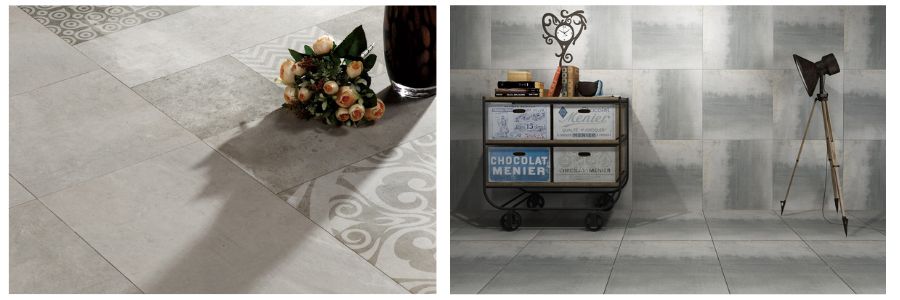

Concrete-look porcelain tiles encapsulate the urban and industrial chic that has become increasingly sought after in contemporary design. These tiles emulate the minimalist aesthetic and textured feel of concrete but offer the superior durability and low maintenance of porcelain.
Their strength and resistance to wear make them suitable for high-traffic areas, both residential and commercial, including living rooms, kitchens, and retail spaces. Additionally, the ability of these tiles to resist moisture and stains makes them a practical choice for bathrooms and outdoor living areas.
Patterned-Look Porcelain Tiles


Patterned look porcelain tiles stand as an eye-catching choice for those aiming to infuse their spaces with vibrancy and uniqueness. These tiles come adorned with a myriad of designs, ranging from intricate geometric patterns to delicate floral motifs, offering an artistic element that can transform any room into a visual masterpiece.
This versatility makes them especially suitable for feature walls, backsplashes, and accent floors. Beyond their aesthetic appeal, patterned-looking porcelain tiles retain all the practical benefits of traditional porcelain, including durability, low maintenance, and moisture resistance, making them ideal for both residential and commercial applications.
Classification by Tile Body Composition
The composition of porcelain tiles plays a crucial role in determining their suitability for various applications. Different types of porcelain tile bodies offer distinct benefits and performance characteristics.
Off-white Body
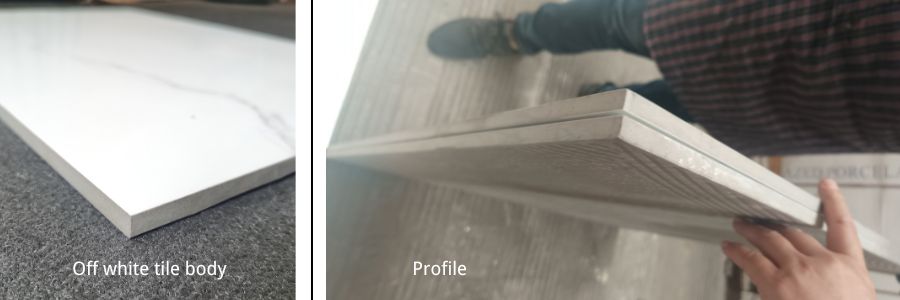

Off-white porcelain tile is often a glazed tile with an off-white tile body and designs printed on the tile surface glazing. Unlike red-body tiles, off-white porcelain tiles don’t turn red because the material contains very few metal oxides such as iron oxide. Besides, off white body can make a light color pattern design of the surface look whiter and softer.
Advantages:
They are durable, have various designs, and are cost-effective.
Common Uses:
Perfect for residential floors and walls, commercial spaces, and minimalist designs.
Full Body


Full-body porcelain tiles have uniform color, texture, and material throughout the tile.
Advantages:
They are highly durable, scratch-resistant, and suitable for heavy-duty applications.
Common Uses:
Ideal for shopping malls, public floors, industrial spaces, and outdoor floors.
Color Body
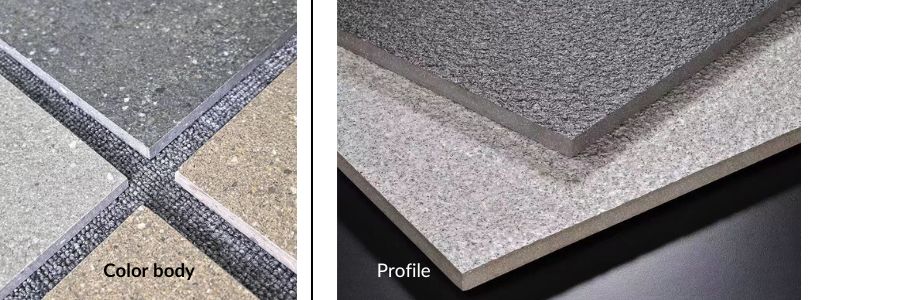

Color body porcelain tiles have a body color that is identical to the surface. This continuity of color reduces the visibility of chips or wear over time, making the tile color look consistent when grooved or cut.
Advantages:
They offer color consistency and pattern integrity. Different from full-body tiles, color body tiles focus on matching the surface and tile body colors to ensure that they look similar, without requiring the material composition to be uniform throughout, so they can have more color and pattern designs. In the meantime, the price is usually lower than a full-body tile.
Common Uses:
Excellent for both residential and commercial projects, such as high-traffic areas like hotels, restaurants, and office lobbies.
Double-Layer Body
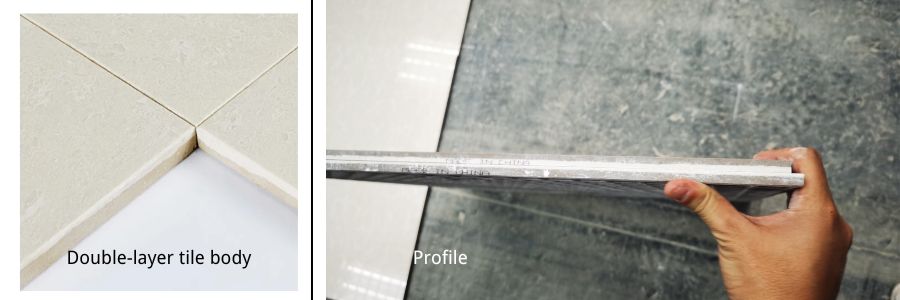

Double-layer porcelain tiles, also known as double-loaded or double-charge porcelain tiles, are a type of tile that features two layers of porcelain pressed together during the manufacturing process.
The top layer, typically about 3 to 4 millimeters thick, is composed of high-quality, highly durable colored porcelain that provides the surface pattern and design. The bottom layer consists of a less expensive base material that offers structural support and additional thickness.
Advantages:
They provide enhanced durability, thicker construction, and superior wear resistance, and they are also cost-effective.
Common Uses:
Suitable for residential and commercial flooring, especially in heavy-traffic areas like airports, kitchens, hallways, and office lobbies.
Classification by Application/Usage
Understanding how different porcelain tiles are classified by their intended application can help importers select the right products for their specific markets and customer needs. Each application environment presents unique challenges that certain tile types are specifically designed to address.
Floor Tiles
Floor porcelain tiles are engineered to withstand regular foot traffic while maintaining their appearance. These tiles typically feature:
- Higher PEI ratings (Class 3-5) to resist abrasion and wear
- Enhanced slip resistance (particularly for commercial spaces)
- Greater thickness (usually 8-12mm) to withstand impact and pressure
- Denser body composition for durability
For high-traffic commercial environments like shopping malls, airports, and hotels, full-body porcelain tiles with a PEI rating of 4 or 5 are ideal. They maintain their appearance even as the surface layer experiences wear over time. For residential floors, glazed porcelain with a PEI rating of 3 or 4 often provides sufficient durability while offering more design flexibility.
Wall Tiles
Wall applications have different requirements than floors since they don’t need to withstand foot traffic. Wall porcelain tiles typically feature:
- Beside the normal thickness, thinner profiles (often 4.5-9mm) to reduce weight on vertical surfaces
- More decorative finishes and intricate designs
- Glossier surfaces since slip resistance isn’t a concern
- Sometimes larger formats to minimize grout lines
Glazed porcelain is particularly popular for wall applications, as it allows for virtually unlimited design possibilities. Color-body porcelain is also an excellent choice for walls, especially in areas where edges might be visible, as the consistent coloration creates a more finished appearance.
Outdoor Tiles
Outdoor porcelain must withstand extreme environmental conditions, including temperature fluctuations, moisture, and UV exposure. Key characteristics include:
- Extremely low water absorption rates (<0.1%) to prevent frost damage
- UV-resistant coloration that won’t fade with sun exposure
- Textured or grip-finished surfaces for slip resistance when wet
- Freeze-thaw resistance for cold climates
Unglazed full-body porcelain with grip finish is typically the best choice for outdoor applications, particularly in areas that experience freezing temperatures. These tiles maintain their performance characteristics and appearance despite years of exposure to the elements.
How to Choose the Right Porcelain Tile?
Selecting the appropriate porcelain tile type involves considering multiple factors that affect both performance and aesthetics. This decision guide will help importers make informed choices based on their specific market requirements.
Determine the Application Environment
The first step is to identify where and how the tile will be used:
| Environment | Primary Concerns | Recommended PorcelainTile Types |
| Residential Indoor Floors | Durability, cleaning ease, comfort | Glazed porcelain Tile (PEI 3-4) Polished Porcelain Tile |
| Commercial Floors | High traffic resistance, safety | Full-body unglazed or color-body (PEI 4-5) |
| Bathroom Walls & Floors | Water resistance, cleaning ease | Glazed porcelain with water-resistant finish |
| Outdoor Floors | Weather resistance, slip safety | Textured homogeneous porcelain tile with grip finish |
| Hotel Lobby | Durability, luxury, cleaning ease | Glazed full polished porcelain with marble look |
| Shopping Mall Floors | Durability, wear resistance, cleaning ease | Polished porcelain tile ( full body or double layer) |
Consider Technical Requirements
Match the tile’s technical specifications to the installation requirements:
Water Absorption Rate:
- Areas exposed to water or moisture: Choose tiles with <0.1% absorption
- Standard indoor areas: Tiles with ≤0.5% absorption are sufficient
- Outdoor areas in freeze-thaw climates: Must use tiles with <0.1% absorption
Slip Resistance:
- Measured by the Dynamic Coefficient of Friction (DCOF) value
- For standard floors: DCOF of 0.42 or greater
Hardness and Durability:
- Low traffic areas: PEI Class 2-3
- Medium traffic areas: PEI Class 3-4 (usually most porcelain tile can reach this rate)
- High traffic commercial areas: PEI Class 4-5
Evaluate Aesthetic Considerations
The visual impact of the tile is equally important for market appeal:
Design Authenticity:
- For natural stone looks: Digital printing technology allows for dozens of unique patterns in porcelain that mimic marble, granite, or travertine
- For wood looks: Consider longer plank formats with textured surfaces that replicate wood grain
Surface Finish Impact:
- Polished finishes: Create reflective, elegant surfaces but may be more slippery when have water
- Matte finishes: Provide better traction and hide dirt more effectively
- Textured finishes: Offer excellent slip resistance but may collect dirt in the texture if no enough cleaning
Budget and Value Considerations
Different porcelain tile types vary significantly in price:
Value-Focused Options:
- Standard glazed porcelain offers good durability at moderate price points
- Soluble salt porcelain and parts of doule layer polished porcelain usually provides basic functionality at entry-level prices
Premium Options:
- Double-loaded porcelain offers excellent wear characteristics for high-traffic areas
- Full-body through-color porcelain provides superior durability and ageless appearance
- Digital printed porcelain with natural stone looks offers luxury aesthetics at a fraction of natural stone prices
When evaluating cost, consider the total lifecycle cost rather than just the initial purchase price. Higher-quality porcelain may cost more initially but often lasts longer and requires less maintenance, providing better long-term value.
Conclusion
Porcelain tiles come in a wide variety of designs and functionalities. Whether it’s the luxury of marble-like tiles or the industrial style of concrete-look tiles, each has its own distinct look. They excel in durability, ease of maintenance, and resistance to wear and moisture.
Understanding the different types of porcelain tile bodies—off-white, full body, color body, and double layer—can help you make an informed selection based on your requirements. Full body and double-layer porcelain tile: have good wear resistance, suitable for heavy traffic areas. Off-white body tile, lower cost, and has many design options. Whereas color body tile, is suitable for cutting and grooved edges but lower cost than full body tile.
Regardless of your choice, porcelain tiles remain an affordable and reliable alternative for both residential and commercial projects.
Frequently Asked Questions
Q 1: What is the main difference between porcelain and ceramic tiles?
A: Porcelain tiles are made from more refined clay and fired at higher temperatures (1,200-1,400°C) than ceramic tiles, resulting in a denser, less porous product with water absorption of 0.5% or less. Ceramic tiles typically have water absorption rates above 0.5% and are less dense.
Q 2: Are porcelain tiles suitable for outdoor use?
A: Yes, unglazed full-body porcelain tiles with low water absorption rates (<0.1%) are excellent for outdoor use, as they resist freezing, thawing, and UV fading. Look for tiles specifically rated for outdoor applications.
Q 3: Can porcelain tiles be used on walls?
A: Absolutely. While porcelain is heavier than ceramic, thinner porcelain tiles (4.5-8mm) are perfectly suitable for wall applications and offer superior durability and moisture resistance compared to ceramic.
Q 4: What does PEI rating mean for porcelain tiles?
A: PEI (Porcelain Enamel Institute) ratings indicate a tile’s durability and resistance to surface wear on a scale from 1-5. PEI 1 is suitable only for walls, while PEI 5 can withstand heavy commercial traffic.
Q 5: What is the difference between glazed and unglazed porcelain?
A: Glazed porcelain has a layer of liquid glass applied to its surface before final firing, creating a protective layer that can incorporate colors and patterns. Unglazed porcelain has no additional surface layer, with color and texture consistent throughout the tile.
Q 6: What does “rectified” mean in porcelain tiles?
A: Rectified tiles have had their edges precisely cut after firing to ensure extremely consistent dimensions. This allows for narrower grout lines (as small as 2mm) and a more seamless appearance in the finished installation.
Q 7: Do different types of porcelain tile require different installation methods?
A: Yes. Large-format tiles require more precise substrate preparation and often need special mortars. Full-body unglazed porcelain may need different sealers than glazed porcelain. Always follow manufacturer recommendations for specific tile types.

